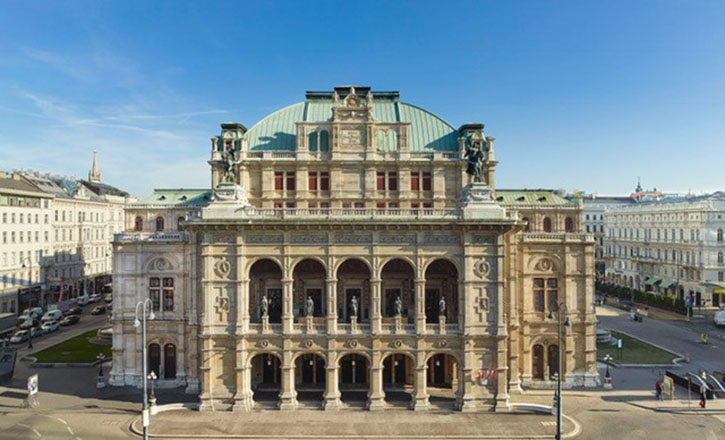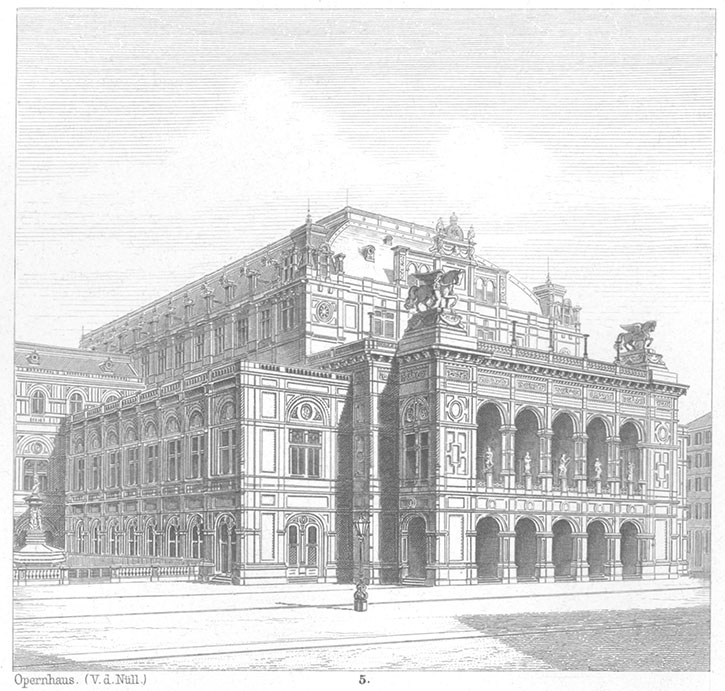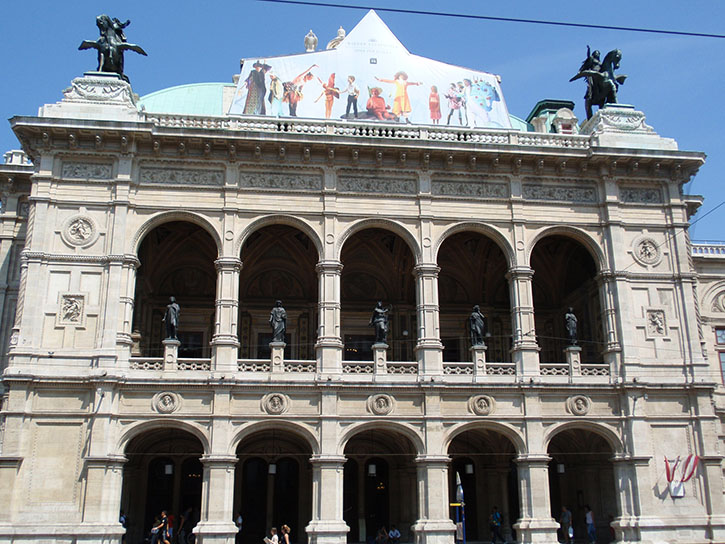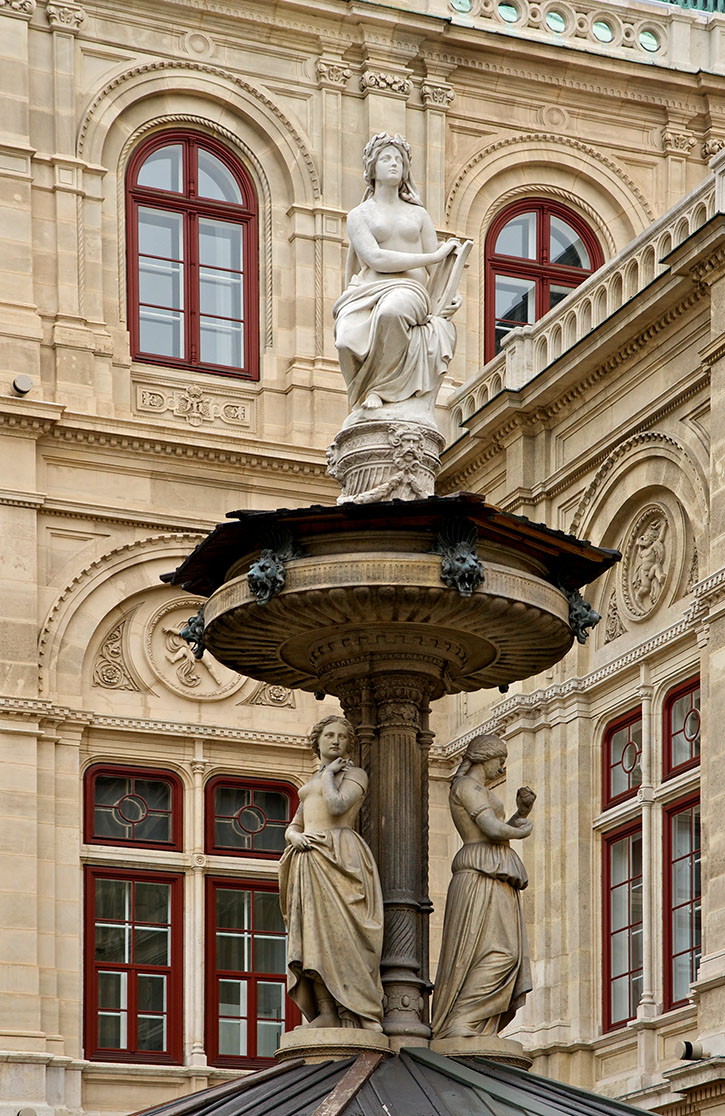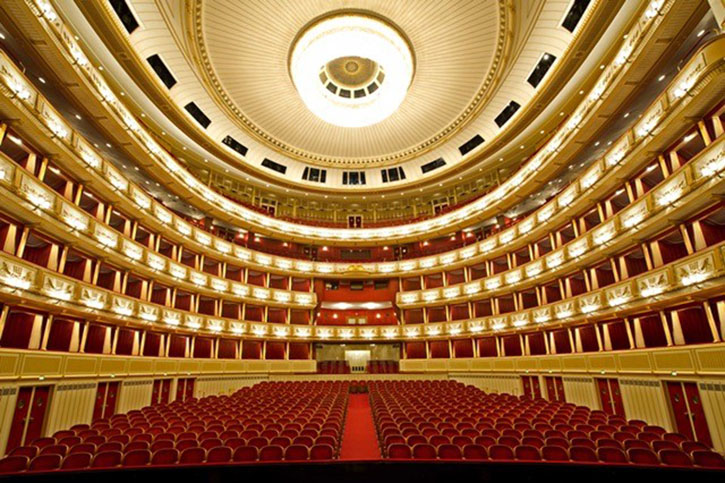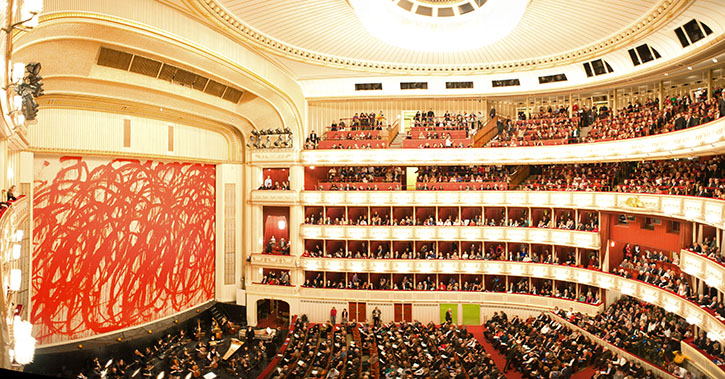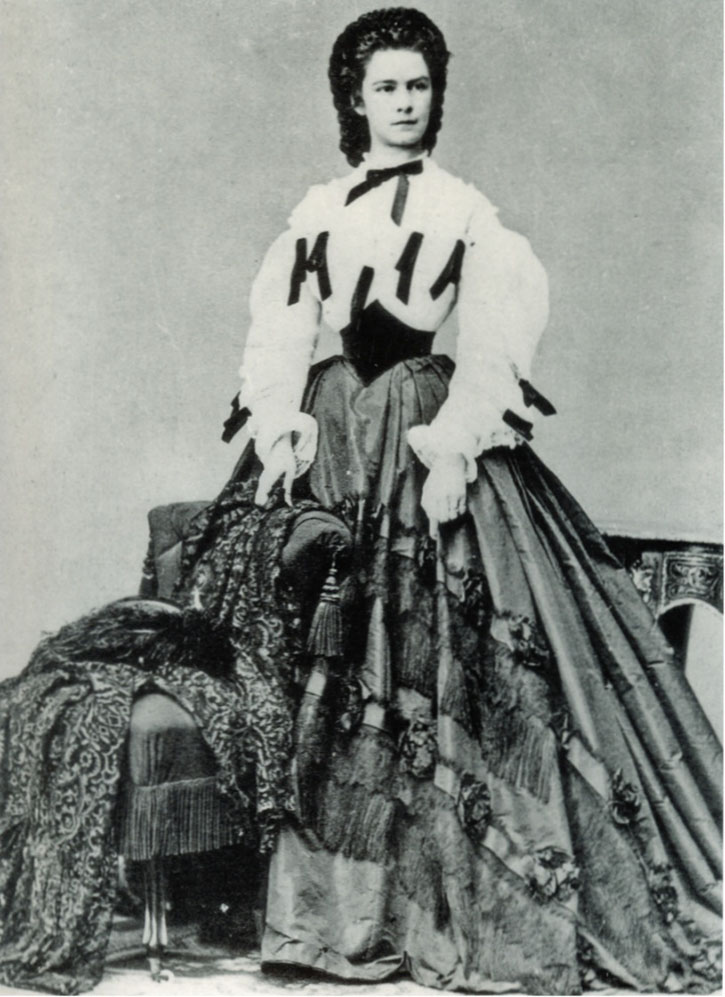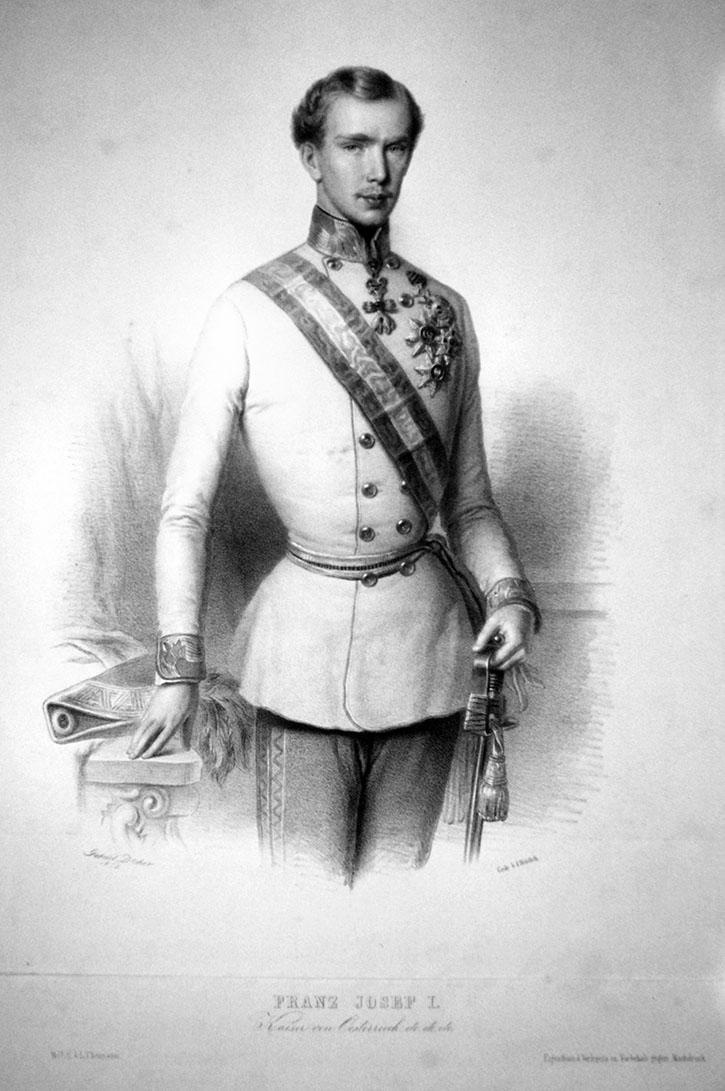The Vienna State Opera is one of the greatest and most famous opera houses of our world. It impresses not only by its architectural aspects, countless world premieres are also part of its repertoire. Commissioned by the husband of the famous empress Sissi, the destruction of 1945 and the reopening in 1955, this house has many stories to tell…
Vienna’s “first house on the ring” was commissioned by Emperor Franz Joseph 1st – the husband of Empress Sissi (Elisabeth). This happened the same time as the reconstruction of the Viennese “Ringstrasse” as a magnificent boulevard. On May 25th 1869, the opera house was opened with “Don Giovanni” (Don Juan) by W.A. Mozart. The Vienna State Opera is one of the most famous and most important opera houses with almost 40 world premieres, numerous new productions and over 50 productions a year. Among the most famous works that premiered are Richard Strauss´ “Rosenkavalier”, Richard Wagner’s “Parsifal”, Franz Schmidt’s “Notre Dame” and Franz Lehár’s “Guiditta”.
When was the Vienna State Opera built?
The call for tender for the planning of the Vienna State Opera took place in 1860. The tendering was won by the friends August von Sicardsburg and Eduard van der Nüll. The architectural competition was decided in 1861 and on May 20th 1863, the foundation stone was laid and the eight-year construction on the monumental building on Vienna’s Ringstrasse began. The completion of the opera was in 1869.
Of course, other artists had influence on the style as well, as you will read more about below.
The Drama and the Emperor´s Anecdote
The planning and construction of the State Opera was financed by the city extension fund created in 1858. It was not just about the opera, the expansion of Vienna’s Ringstrasse as a whole was planned.
Due to bad planning by the Hofbauamt, the “Imperial Buildings Authorities”, the level of the carriageway of the Ringstraße was too high by one meter. That happened after the beginning of the construction of the opera. An incident that had a strong impact on the appearance of the Vienna State Opera in particular.
The public reacted with ridicule towards the architects of the opera and even the Emperor himself accused the opera of the appearance of a “sunken box”. The fact that the blame was not on the architects themselves was either not communicated or simply of no interest for anybody.
One of the architects, Eduard van der Nüll, could not cope with this humiliation and took his own life. Only two months later, the second architect and his best friend, August von Sicardsburg, died of a heart attack. The temporal proximity to the suicide of his friend is certainly no coincidence.
It is said that the emperor took the events so seriously that in the future he refrained from commenting critically on art. He coined the diplomatic sentence “it was very nice, I was very happy”. This sentence became the winged word of the emperor in order not to hurt any feelings. Thus, there is also the quote “This new invention has interested me very much and I thank you for the demonstration of the same” which he used in 1900 in Vienna at the exhibition of objects of the Paris World Expo. Also very diplomatic.
The level of the roadway in front of the house was adjusted later.
Which Opera was played at the Opening of the Vienna State Opera?
The Vienna State Opera has a close connection to W.A. Mozart. For the opening in 1869 his famous work “Don Giovanni” was performed. Don Giovanni, or “Don Juan” is, according to the Köchelverzeichnis, Mozart’s 527th work. The commission for this opera resulted from the previous success of Mozart’s “Marriage of Figaro” and its composition synchronizes with Mozart’s period of mourning due to his father´s death.
The reworking of Mozart’s opera “Idomeneo” was premiered in 1931 at the Vienna State Opera and the foyer of the house is decorated with frescoes depicting scenes from the “Magic Flute”. The management of the house maintains a regular performance of Mozart’s great works.
More information about Mozart’s work and his life can be found in our articles Mozart the Prodigy and Mozart – the adult child.
The Architecture of the Vienna State Opera
The building was designed and shaped in Neo-Renaissance style, which is very close to Classicism. Both styles are difficult to distinguish from each other. As already mentioned, not only the two architects, but also all the artists who designed both the outside and the inside with their sculptures and portraits had an influence on its appearance.
The Facade of the Vienna State Opera
Even the exterior of the building embodies history, drama and portraits, especially when you look at the house from its front. Not to be overlooked are the five present bronze figures in the arcade arches. These five are Heroism, Melpomene (the Muse of tragedy), Fantasy, Thalia (the Muse of funny poetry and entertainment) and Love. The façade is also adorned by two equestrian statues of winged horses led by harmony and muse of poetry.
Artist of the horse and the bronze statues was Ernst Julius Hähnel.
On the two sides of the opera there are two fountains that stand for opposing worlds: the left fountain symbolizes “music, dance, joy, carelessness”, while the right one stands for “Loreley, mourning, love, revenge”. The fountains were created by Josef Gasser.
The Foyer
Inside the Staatsoper there are no fewer portraits than outside. Just above the steps, two high-relief representations by Johann Preleuthner symbolize ballet and opera. Further up, the ceiling painting “Fortuna, scattering its gifts” by Franz Dobiaschofsky. Three further murals of him depict the ballet, the comic and the tragic opera. Furthermore, seven allegorical statues which play a very important role – also by Josef Gasser. They represent the seven liberal arts, namely architecture, sculpture, poetry, dance, sound art, drama and painting.
And not forgetting the two portraits of the architects Nüll and Sicardsburg, which are attached to the first half landing of the impressive grand staircase, designed by the sculptor Josef Cesar.
The Auditorium - how many Seats does the Vienna Opera have?
The state opera house has space for 2.284 culture enthusiasts, thereof 1.709 seats and 567 standing room, as well as 4 wheelchair seats with 4 companions. The orchestra pit accommodates up to 110 musicians. Famous for the auditorium is the “Iron Curtain” designed by Rudolph Eisenmenger. In his original version he shows a motif from the opera “Orpheus and Eurydice” by Christoph Willibald Gluck. Since 1998 “musem in progress” has made it possible to vary the motif on the iron curtain seasonally without destroying the original image. Thanks to a special procedure developed for the fixation of the images.
The People of the Vienna State Opera
As impressive as the building itself is, it would not be as great as it is without the people shaping and filling Vienna’s opera house. Starting with the management, the musical artists, the administration team and all the important cog-wheels that keep this masterpiece going every day. We can not introduce all, but some parts we have picked up from the apparatus.
The Directors of the Vienna State Opera
Not only in its performances the house can adorn itself with musical greats, also with its directorate representatives of the opera it looks back on a long list of celebrities.
Among them, the composer and conductor Gustav Mahler, whose work owes much of its current significance and celebrity. Other well-known names in the management are Felix von Weingartner, Richard Strauss and Herbert von Karajan. You can find the detailed list of directors of the Vienna State Opera here.
The Orchestra of the Vienna State Opera
The State Opera Orchestra is staffed with excellent classical musicians. The most famous orchestra in the world, the Vienna Philharmonic, is also formed from it. Around 90 million viewers watch their New Year’s Concert in the Golden Hall of the Wiener Musikverein via television. In addition, they perform – in addition to their subscription concert series in the Musikverein – worldwide.
The Wiener Staatsopernorchester is the only orchestra in the world that has nightly performances to perform – which are then also contested in repertoire to a considerable extent by temporary workers. (Source: Wikipedia)
The Ballet Academy of the Vienna State Opera
This academy is one of the most traditional in the world for classical ballet together with Saint Petersburg and Paris. Its history dates back to 1771. 100 years later, in 1870 the ballet school was incorporated into the Vienna State Opera, shortly after its opening. The Ballet Academy trains children from the age of 9 to 10 years. Of course, it requires a rigorous entrance exam and a lot of hard work for those admitted. The training lasts eight years and includes subjects such as classical repertoire, rhythm, pas de Deux, later even modern repertoire and anatomy. Through the cooperation with the Bundesrealgymnasium in the Boerhavegasse, to which a boarding school is also connected, it is also possible to graduate with a school leaving exam (or Abitur). Exact information, such as the history in detail, the training or the entrance examination can be found here
This picture of the Vienna State Ballet in the Sydney Opera House shows very clearly the precision in dacing that is taught at the Academy….
Tickets for the Vienna State Opera - and is there a dress code?
Two questions that we can answer in one paragraph:
Tickets for performances in the Vienna State Opera are available almost exclusively through the house itself. So we are all the happier to have tickets for a premiere 2019 – the 150th anniversary of the house – for you:
The Vienna Hofburg Orchestra – one of the best orchestral groups in Vienna- will perform at the Staatsoper on August 13, 2019. They will be accompanied by renowned opera singers Sera Gösch, Eunsie Hong and Franz Suppper.
We have already presented the Vienna Hofburg Orchestra in one of our articles in more detail. Already in 2018, the orchestra was allowed to accompany the Japanese-Austrian festival choir in the State Opera during the performance of Beethoven’s 9th Symphony. On the 13th of August they will perform the most beautiful songs of W.A. Mozart and J. Strauss in the Vienna State Opera!
Concerning the dresscode at the Vienna State Opera: It is similar to what we wrote in our article Classical Concert in Vienna – 7 tips. Conclusions: It is not too strict, but smartening yourself up is part of an evening like this, isn´t it? 😉
CC attributions:
Main picture / article´s head pic: provided by Vienna State Opera
pic 1: File:Opernhaus Wien Staatsoper-Van der Nüll-187x.jpg; Public Domain; author unknown
Created: 1 January 1879
pic 2: CC by Tsukino on wiki – CC BY-SA 3.0 commons; https://commons.wikimedia.org/wiki/Wiener_Staatsoper#/media/File:State_Opera.JPG
pic 3: CC0; by Jebulon; File:Statue fontaine opéra Vienne.jpg on wiki commons
pic 4: provided by Vienna State Opera
pic 5: CC by Mstyslav Chernov – CC BY-SA 3.0 https://commons.wikimedia.org/wiki/Wiener_Staatsoper#/media/File:The_Vienna_State_Opera_(Wiener_Staatsoper)_interior._Vienna,_Austria,_Western_Europe.jpg
pic 6: Sisi 1862, by Ludwig Angerer, Public Domain
pic 7: Franz Joseph I. Kaiser von Österreich 1853 by Gabriel Decker, Public Domain
